The Mediterranean coast of Cyprus is more than beautiful — amidst the deep blue waters and crags and boulders on the rocky coastline, you’ll find something legendary.
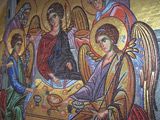 |
| Beautiful mosaics adorn the walls of churches and monasteries throughout Cyprus. |
Not far outside of Paphos, visitors pull off the coastal highway by the busload to catch a glimpse of a well-known scenic spot.
“This is the legendary birthplace of Aphrodite, the goddess of love and beauty,” guide Kristiana said as she guided my small group out of our bus and down toward the beach. “She was born on top of that large rock in the water.”
At midmorning, this coastal spot was busy with visitors from around the world, who had stopped to see the legendary spot. Some wore bathing suits and waded into the cool waters — according to the myth, if followers swim around Aphrodite’s rock three times counterclockwise they will be blessed with renewed youth. Kristiana called it a 40-year facelift.
|
IT MUST BE THE CLAY JARS When it comes to wine, Cyprus has some serious bragging rights. Today, there are some 100 varieties of grapes grown on the island. Out of those, about 30 are used for winemaking. In the mountain village of Omodos, visitors can see the process locals have used to make wine for hundreds of years. The village still uses a winepress that dates back to the 14th century, where large wheels and levers are used to crush grapes and extract the juice. Because no oak trees grow in Cyprus, there are no oak barrels. Instead, visitors see the large clay jars that locals have used to store and ferment their wines for centuries. Wine lovers can buy bottles of local wine in Omodos, and if they’re especially brave, they can visit local restaurants to taste the homemade wines still produced by village families. But be forewarned: The wines made in Cyprus’ villages are notoriously strong. When the British controlled the island in the 1800s, British soldiers got drunk on the wine so quickly that the government tried to outlaw winemaking in the villages. |
“A lot of Russian tourists really get into it,” she said. “I see them going out and swimming around the rock.
Unfortunately, sometimes they’re going around the wrong rock, but I don’t have the heart to tell them.”
Aphrodite’s birthplace is just one of the spots in Cyprus where the island nation’s natural beauty and extensive history intersect. This country enjoys more than 300 days of sunshine each year, along with a history that ranges from the time of the ancient Greeks to early Christian missionaries and beyond.
I joined a group of travel agents and tour operators for a five-day tour of the country last fall as a guest of the Cyprus Tourism Organization. Together, we found that Cyprus’ many historic epochs help make it a wonderful destination to enjoy.
Land of beauty
It’s no surprise that the ancient Greeks associated their goddess of beauty with Cyprus — from the seashores to the olive orchards and mountain villages, Cyprus is peaceful and picturesque. The 3,500-square-mile island is home to some 950,000 residents, who enjoy beautiful views and a rich history.
In addition to being born on the coast of Cyprus, Aphrodite was also believed to have lived on the island. Near the city of Polis, we visited the Baths of Aphrodite, another beautiful site that legend maintains was a favorite of the goddess.
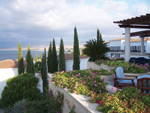 |
| Resort hotels give guests beautiful views of the Mediterranean Sea. |
“This is where Greek mythology says that Aphrodite would bring all of her lovers in secret,” Kristiana told us as we made our way down the short path toward the hidden pools. “She was married to Hephaestus, but he was an ugly god. So she had to compensate.”
The baths are hidden inside a small cave, where water slowly drips in from the mountains above. The secluded spot is cool and peaceful — some might say the perfect place for a tryst were it not for the eels and water snakes that make their home in the pools.
Like the birthplace, the Baths of Aphrodite are said to have some restorative qualities. Some of the water runoff from the mountain is channeled into fountains just outside the cave where visitors can dip their hands and wash their faces. The ancients believed that the waters restored youth and beauty because of Aphrodite’s magic; today, scientists think that it is the rich mineral deposits from the mountains that make these waters good for your skin.
Archaeological treasures
Cyprus’ associations with the classical world aren’t merely mythological. The island is close to Greece geographically and politically, and Greek is the island’s official language. In the centuries before Christ, Cyprus was part of the Greek confederation; later it came under the rule of the Roman Empire.
Several archaeological sites around the island give visitors a glimpse of the art and architecture of the Greeks and Romans. One of the most extensive is Kourion, a city that was active during the Hellenistic, Roman and early Christian periods.
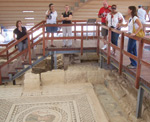 |
| The group explores the ruins at Kourion, which include well-preserved floor mosaics. |
“This is a kingdom that was alive from the fifth century B.C. to the fifth century A.D.,” Kristiana told us. “It’s a mixed civilization. We see influences from Greece, influences from Egypt and influences from Phoenicia.”
One of the main sites at Kourion is a Roman house that dates to the mid-400s A.D. Underneath a protective awning, we walked on platforms over a beautiful mosaic floor that was inside the home. The mosaics originally covered the entire floor of the house, with images depicting scenes from both classical mythology and biblical stories.
The most striking ruin at Kourion is an amphitheater constructed in the second century before Christ. The stone seats and stage are well preserved. During the Roman period, this theater held about 3,500 people, who would come to see Christians fed to lions.
|
POLITICAL PUZZLE Though 80 percent of Cypriots are ethnically Greek, a contingent of about 18 percent are of Turkish descent. From the time of its independence in 1960 until 1974, the country was governed by a coalition of Greek and Turkish Cypriots; in 1974, however, the country was invaded by Turkish troops, who now occupy 36 percent of the island, including all of the traditionally Turkish territories. The invasion and subsequent occupation remain a bone of contention between Turkey and Greece and Cyprus. The Greek Cypriot government maintains that the actions are a violation of international law and continue to demand a total withdraw of Turkish forces. Greece and Cyprus oppose Turkey’s application to join the European Union on these grounds. In spite of the conflict, however, there is no political violence on the island, and tourism remains completely safe for international visitors. The Cyprus Tourism Organization is a bureau of the Greek Cypriot government and promotes only those destinations that are in unoccupied parts of the island. |
On the day we visited, the scenery was not grotesque, but appealing. From our seats in the grandstands, we saw a film crew from Sri Lanka shooting a documentary about Kourion. Beyond them, the Mediterranean Sea gleamed in the distance.
There are more extensive ruins and murals at Kato, a site just outside of Paphos, where archaeologists have found a large home belonging to a Roman governor as well as other villas dating back to the third century B.C.
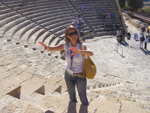 |
| Guide Kristiana explains the origins of this amphitheater at Kourion. |
Inside the governor’s house, we saw large floor murals that were almost completely intact. They depicted scenes from the myth of Dionysus, including his return from battle in India with the spoils of war.
“All of the Roman governors loved to have mosaics depicting Greek mythology in their houses,” Kristiana told us. “These mosaics are 1,500 years old, but they look like they were done yesterday.”
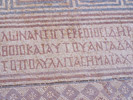 |
| The detail work of a floor mosaic from the archaeological site is remarkable. |
A look at the murals in the house, as well as some found outside, is a lesson in both art and mythology. In addition to the depictions of Dionysus, the murals show scenes of Theseus and the Minotaur, as well as baby Achilles having his heel dipped in the river Styx.
Christian influence
Since the fall of the Roman Empire, Christianity has been the most influential force in Cyprus. The country is overwhelmingly orthodox and has a number of beautiful churches and monasteries.
In biblical history, Paphos is notable as the hometown of Barnabas and as a place that Paul visited on his first missionary journey, with painful results. In the historic area of the city, a pillar is set up in the public square to commemorate the place where Paul was persecuted during his visit.
“This is the public place where he was captured and lashed 39 times,” Kristiana said.
The initial flogging notwithstanding, Paul’s message eventually made an impact on the locals, who went on to build a basilica on the site where he was beaten. The church was one of the first basilicas in the eastern Mediterranean. Today, visitors to the site can see ruins of the original basilica and can visit the 16th-century church that replaced it.
Visiting churches and monasteries is an important part of understanding Cyprus. One of the most significant is the Cathedral of St. John in the capital city of Nicosia. The cathedral was built in the 17th century by French Dominican monks and contains numerous examples of historic sacred art.
During our visit to the church, local guide Maro explained that the art inside was designed to teach and inspire congregants. The walls of the cathedral are covered from floor to ceiling with hand-painted murals showing events and miracles from the life of Jesus.
“Inside, you’ll see that it’s very rich in 18th-century paintings and icons,” she said. “In that time, paintings were used to tell the story of Jesus Christ. It was like a book for the people who couldn’t read.”
From the myths on the shoreline to the parables painted inside the cathedrals, it’s centuries of these stories that makes Cyprus special.









